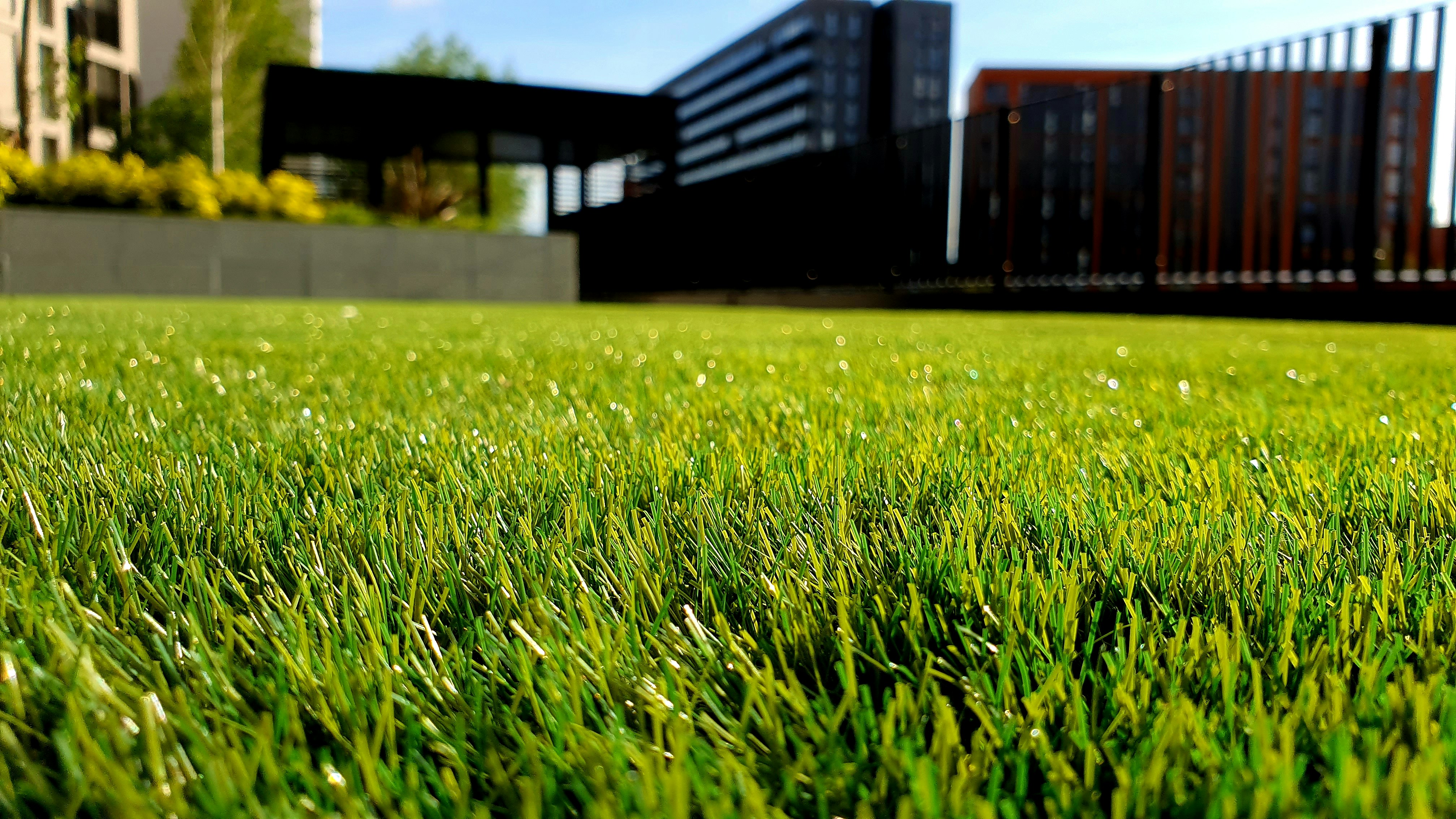Mowing
Mowing
Mowing
Mowing
Is Your Lawn Hungry? How to Fertilize Right
Fertilizer is key to a healthy lawn. Learn how to choose the right fertilizer, understand application timing, and decode those numbers on the bag.
Is Your Lawn Hungry? How to Fertilize Right
Fertilizer is key to a healthy lawn. Learn how to choose the right fertilizer, understand application timing, and decode those numbers on the bag.
Is Your Lawn Hungry? How to Fertilize Right
Fertilizer is key to a healthy lawn. Learn how to choose the right fertilizer, understand application timing, and decode those numbers on the bag.
Is Your Lawn Hungry? How to Fertilize Right
Fertilizer is key to a healthy lawn. Learn how to choose the right fertilizer, understand application timing, and decode those numbers on the bag.

Written by
Stephen V

Written by
Stephen V

Written by
Stephen V

Written by
Stephen V




Ever look out at your lawn and feel like it's just... lacking? Maybe the color is dull, the growth is patchy, or weeds seem to be thriving. If so, your lawn might be sending you a hunger signal! Just like us, lawns need proper nourishment to stay healthy and vibrant. But how do you know if it's time to fertilize, and how do you do it right? Don't worry, this guide will turn you into a lawn care expert in no time.
Signs Your Lawn Needs a Feeding Frenzy
Yellowing or Thinning Grass: Chlorophyll, the pigment that gives grass its green color, needs nitrogen. If your lawn is losing its vibrant hue or appears patchy, it could be nitrogen deficient.
Slow Growth: A healthy lawn should recover quickly from wear and tear. If your grass seems stagnant, lacking that springy bounce, it might need a nutrient boost.
Weeds Taking Over: Weeds love weak, undernourished lawns. If they're flourishing more than your grass, it's a sign your lawn needs some help competing for nutrients.
Choosing the Right Feast for Your Lawn
Not all fertilizers are created equal. Here's what to consider when picking the perfect food for your hungry lawn:
Grass Type: Different grass types have different needs. Identify your grass species (cool-season vs. warm-season) to choose a fertilizer formulated for its specific requirements.
Soil Test: For a truly personalized approach, consider getting a soil test. This will reveal your soil's nutrient levels and any deficiencies that need addressing.
NPK Ratio: Pay attention to the NPK ratio on fertilizer bags. N stands for nitrogen, P for phosphorus, and K for potassium. These are the essential nutrients for healthy grass growth. Choose a fertilizer with an NPK ratio suitable for your grass type and season.
Feeding Frenzy Done Right: Proper Fertilization Techniques
Timing is Key: The best time to fertilize depends on your grass type and climate. Generally, cool-season grasses benefit from fertilization in early spring and fall, while warm-season grasses prefer feeding in late spring and summer.
Follow the Instructions: Read and follow the application instructions on the fertilizer bag carefully. Applying too much fertilizer can damage your lawn and pollute waterways.
Spread Evenly: Use a spreader to ensure even fertilizer distribution across your lawn. This prevents patchy growth and wasted product.
Water Wisely: After fertilizing, water your lawn deeply to help the nutrients reach the roots.
More Than Just Food: A Balanced Diet for Your Lawn
Fertilizer is just one piece of the lawn care puzzle. Here are some additional tips for a healthy, happy lawn:
Mow Properly: Maintain the correct mowing height for your grass type. This promotes healthy growth and discourages weeds.
Water Deeply: Deep watering encourages strong root growth, making your lawn more resilient.
Aerate Regularly: Compacted soil restricts air and water flow. Aeration helps loosen the soil and improve root health.
By understanding your lawn's needs, choosing the right fertilizer, and following proper application techniques, you can give your lawn the feast it deserves. Remember, a well-fed lawn is a happy lawn, rewarding you with a beautiful green oasis for years to come.
Ever look out at your lawn and feel like it's just... lacking? Maybe the color is dull, the growth is patchy, or weeds seem to be thriving. If so, your lawn might be sending you a hunger signal! Just like us, lawns need proper nourishment to stay healthy and vibrant. But how do you know if it's time to fertilize, and how do you do it right? Don't worry, this guide will turn you into a lawn care expert in no time.
Signs Your Lawn Needs a Feeding Frenzy
Yellowing or Thinning Grass: Chlorophyll, the pigment that gives grass its green color, needs nitrogen. If your lawn is losing its vibrant hue or appears patchy, it could be nitrogen deficient.
Slow Growth: A healthy lawn should recover quickly from wear and tear. If your grass seems stagnant, lacking that springy bounce, it might need a nutrient boost.
Weeds Taking Over: Weeds love weak, undernourished lawns. If they're flourishing more than your grass, it's a sign your lawn needs some help competing for nutrients.
Choosing the Right Feast for Your Lawn
Not all fertilizers are created equal. Here's what to consider when picking the perfect food for your hungry lawn:
Grass Type: Different grass types have different needs. Identify your grass species (cool-season vs. warm-season) to choose a fertilizer formulated for its specific requirements.
Soil Test: For a truly personalized approach, consider getting a soil test. This will reveal your soil's nutrient levels and any deficiencies that need addressing.
NPK Ratio: Pay attention to the NPK ratio on fertilizer bags. N stands for nitrogen, P for phosphorus, and K for potassium. These are the essential nutrients for healthy grass growth. Choose a fertilizer with an NPK ratio suitable for your grass type and season.
Feeding Frenzy Done Right: Proper Fertilization Techniques
Timing is Key: The best time to fertilize depends on your grass type and climate. Generally, cool-season grasses benefit from fertilization in early spring and fall, while warm-season grasses prefer feeding in late spring and summer.
Follow the Instructions: Read and follow the application instructions on the fertilizer bag carefully. Applying too much fertilizer can damage your lawn and pollute waterways.
Spread Evenly: Use a spreader to ensure even fertilizer distribution across your lawn. This prevents patchy growth and wasted product.
Water Wisely: After fertilizing, water your lawn deeply to help the nutrients reach the roots.
More Than Just Food: A Balanced Diet for Your Lawn
Fertilizer is just one piece of the lawn care puzzle. Here are some additional tips for a healthy, happy lawn:
Mow Properly: Maintain the correct mowing height for your grass type. This promotes healthy growth and discourages weeds.
Water Deeply: Deep watering encourages strong root growth, making your lawn more resilient.
Aerate Regularly: Compacted soil restricts air and water flow. Aeration helps loosen the soil and improve root health.
By understanding your lawn's needs, choosing the right fertilizer, and following proper application techniques, you can give your lawn the feast it deserves. Remember, a well-fed lawn is a happy lawn, rewarding you with a beautiful green oasis for years to come.
Ever look out at your lawn and feel like it's just... lacking? Maybe the color is dull, the growth is patchy, or weeds seem to be thriving. If so, your lawn might be sending you a hunger signal! Just like us, lawns need proper nourishment to stay healthy and vibrant. But how do you know if it's time to fertilize, and how do you do it right? Don't worry, this guide will turn you into a lawn care expert in no time.
Signs Your Lawn Needs a Feeding Frenzy
Yellowing or Thinning Grass: Chlorophyll, the pigment that gives grass its green color, needs nitrogen. If your lawn is losing its vibrant hue or appears patchy, it could be nitrogen deficient.
Slow Growth: A healthy lawn should recover quickly from wear and tear. If your grass seems stagnant, lacking that springy bounce, it might need a nutrient boost.
Weeds Taking Over: Weeds love weak, undernourished lawns. If they're flourishing more than your grass, it's a sign your lawn needs some help competing for nutrients.
Choosing the Right Feast for Your Lawn
Not all fertilizers are created equal. Here's what to consider when picking the perfect food for your hungry lawn:
Grass Type: Different grass types have different needs. Identify your grass species (cool-season vs. warm-season) to choose a fertilizer formulated for its specific requirements.
Soil Test: For a truly personalized approach, consider getting a soil test. This will reveal your soil's nutrient levels and any deficiencies that need addressing.
NPK Ratio: Pay attention to the NPK ratio on fertilizer bags. N stands for nitrogen, P for phosphorus, and K for potassium. These are the essential nutrients for healthy grass growth. Choose a fertilizer with an NPK ratio suitable for your grass type and season.
Feeding Frenzy Done Right: Proper Fertilization Techniques
Timing is Key: The best time to fertilize depends on your grass type and climate. Generally, cool-season grasses benefit from fertilization in early spring and fall, while warm-season grasses prefer feeding in late spring and summer.
Follow the Instructions: Read and follow the application instructions on the fertilizer bag carefully. Applying too much fertilizer can damage your lawn and pollute waterways.
Spread Evenly: Use a spreader to ensure even fertilizer distribution across your lawn. This prevents patchy growth and wasted product.
Water Wisely: After fertilizing, water your lawn deeply to help the nutrients reach the roots.
More Than Just Food: A Balanced Diet for Your Lawn
Fertilizer is just one piece of the lawn care puzzle. Here are some additional tips for a healthy, happy lawn:
Mow Properly: Maintain the correct mowing height for your grass type. This promotes healthy growth and discourages weeds.
Water Deeply: Deep watering encourages strong root growth, making your lawn more resilient.
Aerate Regularly: Compacted soil restricts air and water flow. Aeration helps loosen the soil and improve root health.
By understanding your lawn's needs, choosing the right fertilizer, and following proper application techniques, you can give your lawn the feast it deserves. Remember, a well-fed lawn is a happy lawn, rewarding you with a beautiful green oasis for years to come.
Ever look out at your lawn and feel like it's just... lacking? Maybe the color is dull, the growth is patchy, or weeds seem to be thriving. If so, your lawn might be sending you a hunger signal! Just like us, lawns need proper nourishment to stay healthy and vibrant. But how do you know if it's time to fertilize, and how do you do it right? Don't worry, this guide will turn you into a lawn care expert in no time.
Signs Your Lawn Needs a Feeding Frenzy
Yellowing or Thinning Grass: Chlorophyll, the pigment that gives grass its green color, needs nitrogen. If your lawn is losing its vibrant hue or appears patchy, it could be nitrogen deficient.
Slow Growth: A healthy lawn should recover quickly from wear and tear. If your grass seems stagnant, lacking that springy bounce, it might need a nutrient boost.
Weeds Taking Over: Weeds love weak, undernourished lawns. If they're flourishing more than your grass, it's a sign your lawn needs some help competing for nutrients.
Choosing the Right Feast for Your Lawn
Not all fertilizers are created equal. Here's what to consider when picking the perfect food for your hungry lawn:
Grass Type: Different grass types have different needs. Identify your grass species (cool-season vs. warm-season) to choose a fertilizer formulated for its specific requirements.
Soil Test: For a truly personalized approach, consider getting a soil test. This will reveal your soil's nutrient levels and any deficiencies that need addressing.
NPK Ratio: Pay attention to the NPK ratio on fertilizer bags. N stands for nitrogen, P for phosphorus, and K for potassium. These are the essential nutrients for healthy grass growth. Choose a fertilizer with an NPK ratio suitable for your grass type and season.
Feeding Frenzy Done Right: Proper Fertilization Techniques
Timing is Key: The best time to fertilize depends on your grass type and climate. Generally, cool-season grasses benefit from fertilization in early spring and fall, while warm-season grasses prefer feeding in late spring and summer.
Follow the Instructions: Read and follow the application instructions on the fertilizer bag carefully. Applying too much fertilizer can damage your lawn and pollute waterways.
Spread Evenly: Use a spreader to ensure even fertilizer distribution across your lawn. This prevents patchy growth and wasted product.
Water Wisely: After fertilizing, water your lawn deeply to help the nutrients reach the roots.
More Than Just Food: A Balanced Diet for Your Lawn
Fertilizer is just one piece of the lawn care puzzle. Here are some additional tips for a healthy, happy lawn:
Mow Properly: Maintain the correct mowing height for your grass type. This promotes healthy growth and discourages weeds.
Water Deeply: Deep watering encourages strong root growth, making your lawn more resilient.
Aerate Regularly: Compacted soil restricts air and water flow. Aeration helps loosen the soil and improve root health.
By understanding your lawn's needs, choosing the right fertilizer, and following proper application techniques, you can give your lawn the feast it deserves. Remember, a well-fed lawn is a happy lawn, rewarding you with a beautiful green oasis for years to come.
Blog
The Lush Lawn Blog
Learn about lawn care basics, seasonal tips, pest control, troubleshooting, and more.
Contact Us
Get Your Free Lawn Care Quote
Curious about how we can help, or have specific lawn concerns? Drop us a line, and we'll get back to you within 24 hours.

